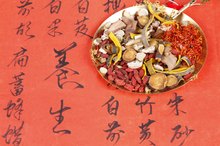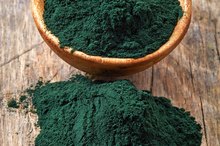What does fact checked mean?
At Healthfully, we strive to deliver objective content that is accurate and up-to-date. Our team periodically reviews articles in order to ensure content quality. The sources cited below consist of evidence from peer-reviewed journals, prominent medical organizations, academic associations, and government data.
The information contained on this site is for informational purposes only, and should not be used as a substitute for the advice of a professional health care provider. Please check with the appropriate physician regarding health questions and concerns. Although we strive to deliver accurate and up-to-date information, no guarantee to that effect is made.
Chlorophyll & Underarm Odor
Chlorophyll is a natural ingredient that purportedly banishes all types of bodily scents, including underarm odor and even bad breath. But before you believe marketing claims made by chlorophyll supplements, hang on to your antiperspirant. Although used traditionally to improve body odor, chlorophyll supplements are classified as dietary in nature by the U.S. Food and Drug Administration. Within this drug classification, there is not enough clinical evidence to prove chlorophyll's efficacy.
About Chlorophyll
Chlorophyll is a naturally occurring chelate, explains Bassam Z. Shakhashiri, a chemistry professor at the University of Wisconsin – Madison 2. It absorbs energy from the sun and turns it into energy through the process known as photosynthesis. Chlorophyll also gives plants their healthy green color.
Chlorophyll Products
The Effects of Testosterone Boosters on the Body
Learn More
The University of Michigan Health System indicates that you can get chlorophyll through the food you eat, such as:
- spirulina
- chlorella 2
Several herbs are sources of chlorophyll, states the Natural Standard website, including parsley, alfalfa and nettle. Dietary supplements may be sold in tablets and capsules, powders and drinks.
Time Magazine
A July 1950 "TIME" magazine article extolled the benefits of chlorophyll, which was subjectively studied by a New York City doctor named Franklin Howard Westcott, who gave it to anemia patients to curb the smell of their urine 1. Suspecting that chlorophyll may also work for bad breath and other body odors, he used other doctors and nurses as a part of an informal study group. Purportedly, Dr. West found that when they took chlorophyll, underarm odor was either considerably reduced or nixed completely 24 hours after a chlorophyll bath. The same year the article was published, a product, Nullo, which contained chlorophyll, was released to consumers. Nullo claimed to get rid of body odor and bad breath within a couple of hours after taking the tablets.
- A July 1950 "TIME" magazine article extolled the benefits of chlorophyll, which was subjectively studied by a New York City doctor named Franklin Howard Westcott, who gave it to anemia patients to curb the smell of their urine 1.
- Suspecting that chlorophyll may also work for bad breath and other body odors, he used other doctors and nurses as a part of an informal study group.
What Medical Experts Say
What Is GoYin?
Learn More
National Council Against Health Fraud vice president James A. Lowell, Ph.D., and integrative physician Dr. Andrew Weil both say that chlorophyll cannot be absorbed by the human body when taken internally 3.
Bottom Line
As noted by Dr. Weil and Dr. Lowell, marketers continue to claim that chlorophyll supplements work wonders on a variety of medical conditions, the aesthetic problem of body odor included. In fact, Nullo, one of the original chlorophyll products manufactured, continues to be available as of June 2010. The University of Michigan Health System states that there's no optimal dosage of chlorophyll that is suggested for use 2. However, the 1950 "TIME" magazine article claimed that 100 milligrams was enough for the "average man."
- As noted by Dr. Weil and Dr. Lowell, marketers continue to claim that chlorophyll supplements work wonders on a variety of medical conditions, the aesthetic problem of body odor included.
Related Articles
References
- TIME Magazine: Medicine-A Sweeter Smell
- Oregon State University: Chlorophyll
- National Council Against Health Fraud: Chlorophyll
- BeBeautiful.com. Benefits of Chlorophyll for Your Skin. By Vishwa Khare. April 29, 2018. Mumbai, Maharashtra, India: BeBeautiful [email protected] https://www.bebeautiful.in/articles/benefits-of-chlorophyll-for-your-skin
- Vaňková K, Marková I, Jašprová J, et al. Chlorophyll-Mediated Changes in the Redox Status of Pancreatic Cancer Cells Are Associated with Its Anticancer Effects. Oxid Med Cell Longev. 2018;2018:4069167. doi:10.1155/2018/4069167
- McQuistan TJ, Simonich MT, Pratt MM, et al. Cancer chemoprevention by dietary chlorophylls: a 12,000-animal dose-dose matrix biomarker and tumor study. Food Chem Toxicol. 2012;50(2):341–352. doi:10.1016/j.fct.2011.10.065
- MedlinePlus. US National Library of Medicine. Chlorophyll. 10/16/2017. Last updated 23 March 2020. Bethesda, Md.: U.S. National Library of Medicine U.S. Department of Health and Human Services National Institutes of Health 2020 https://medlineplus.gov/ency/article/002893.htm
- Ferruzzi MG, Blakeslee J. Digestion, absorption, and cancer preventative activity of dietary chlorophyll derivatives. Nutrition Research. 2007;27(1):1-12. doi:10.1016/j.nutres.2006.12.003
- Chimploy K, Díaz GD, Li Q, et al. E2F4 and ribonucleotide reductase mediate S-phase arrest in colon cancer cells treated with chlorophyllin. Int J Cancer. 2009;125(9):2086–2094. doi:10.1002/ijc.24559
- Yun CH, Jeong HG, Jhoun JW, Guengerich FP. Non-specific inhibition of cytochrome P450 activities by chlorophyllin in human and rat liver microsomes. Carcinogenesis. 1995;16(6):1437-1440. doi:10.1093/carcin/16.6.1437
- Yun CH, Jeong HG, Jhoun JW, Guengerich FP. Non-specific inhibition of cytochrome P450 activities by chlorophyllin in human and rat liver microsomes. Carcinogenesis. 1995;16(6):1437-1440. doi:10.1093/carcin/16.6.1437
- Xu XF, Hu JP, Cheng X, et al. Effects of sodium ferrous chlorophyll treatment on anemia of hemodialysis patients and relevant biochemical parameters. J Biol Regul Homeost Agents. 2016;30(1):135-140.
- Wangcharoen W, Phimphilai S. Chlorophyll and total phenolic contents, antioxidant activities and consumer acceptance test of processed grass drinks. J Food Sci Technol. 2016;53(12):4135–4140. doi:10.1007/s13197-016-2380-z
- Stenblom EL, Montelius C, Östbring K, et al. Supplementation by thylakoids to a high carbohydrate meal decreases feelings of hunger, elevates CCK levels and prevents postprandial hypoglycaemia in overweight women. Appetite. 2013;68:118-23. doi:10.1016/j.appet.2013.04.022
- Köhnke R, Lindqvist A, Göransson N, et al. Thylakoids suppress appetite by increasing cholecystokinin resulting in lower food intake and body weight in high-fat fed mice. Phytother Res. 2009;23(12):1778-1783. doi:10.1002/ptr.2855
- Linus Pauling Institute. Micronutrient Information Center. Oregon State University. Chlorophyll and Chlorophyllin. Summary. Reviewed June 2009. Corvallis, Oregon: Linus Pauling Institute Oregon State University 2020 https://lpi.oregonstate.edu/mic/dietary-factors/phytochemicals/chlorophyll-chlorophyllin
Resources
Writer Bio
Lisa Sefcik has been writing professionally since 1987. Her subject matter includes pet care, travel, consumer reviews, classical music and entertainment. She's worked as a policy analyst, news reporter and freelance writer/columnist for Cox Publications and numerous national print publications. Sefcik holds a paralegal certification as well as degrees in journalism and piano performance from the University of Texas at Austin.









